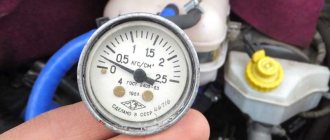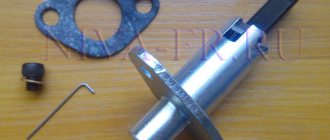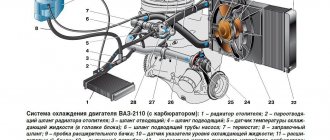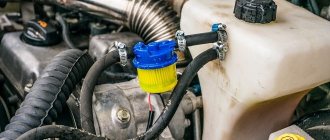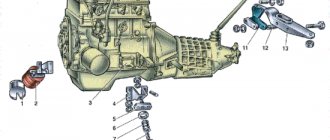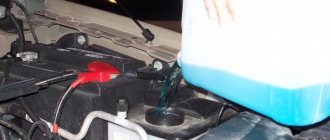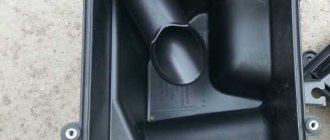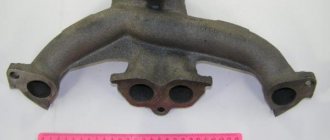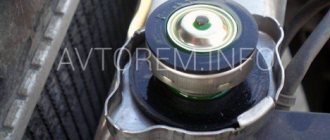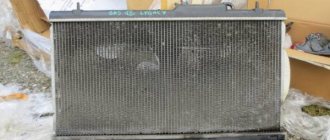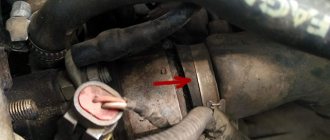How to remove an air lock?
An air lock in the engine cooling system is one of the main reasons for the engine taking a long time to warm up to operating temperature. Therefore, every driver should be interested in removing air lock from the cooling system of his car.
How to properly remove an air lock from the cooling system?
According to the law of physics, air accumulates in the highest place. In a car, the highest link in the coolant chain is the throttle body. That is why the air must be removed from there. There are several ways to get rid of an air lock. Here's the first one from the bottom:
If you have a 1.6 liter engine, then the first step is to remove the plastic cover on the engine - unscrew the cover on the engine to fill the oil, and then pull out the entire cover. It is seated on rubber seals. After removing this plastic screen, screw the oil cap back on to prevent dirt from getting into the crankcase.
- We find the heating pipes for the throttle assembly (there are 2 of them), see the figure. Pick up any phone
- Next, unscrew the cap of the expansion tank (coolant reservoir) and cover the neck of the tank with a clean rag.
- We begin to blow into the tank with liquid. We blow until all the air comes out of the hose and antifreeze flows out.
- We quickly put the tube back on and tighten it with a clamp so that no air gets in.
(It is worth noting that depending on the tube that you removed, antifreeze may leak from both the tube and the fitting from which the tube was removed)
The second method of removing air from the cooling system is less perverted. There is no need to blow anything here:
- Warm up the engine to operating temperature
- Warm up, turn off the engine
- The expansion tank cap does NOT need to be unscrewed.
- As in the first method, unscrew the clamp of the coolant pipe on the throttle assembly.
- Having removed the heating pipe of the throttle assembly, release the air, and after the antifreeze begins to flow out, immediately put it back on the fitting and secure it well with a clamp.
But be careful and careful! Don't forget that the coolant temperature is approximately 90 degrees.
There is also a simpler, but less effective way to eliminate an air lock:
1) We drive up a steep hill so that the radiator cap becomes the highest point of the cooling system.
2) Unscrew the cap of the expansion tank and the radiator cap.
3) Let the car warm up to operating temperature
4) Then we accelerate several times and at the same time add coolant into the barrel.
Do this until bubbles stop appearing.
How to remove an air lock on a VAZ with electronic (e-gas)?
Since there is no throttle valve cooling system, you need to bypass this unit. Here you can also set the car up.
I hope that these three methods will help you solve the problem, and that you have found all the answers to your questions on the topic “How to get rid of an airlock?”
Home page
Is it necessary to warm up an injection engine?
lada-vaz-2114.ru
Method 2
A more sophisticated and effective way to get rid of a traffic jam is to create pressure in the system by the owner of the car himself. Briefly, the essence of the method is the following steps:
- Unscrew the engine oil filler cap;
- Remove the rubber gasket from it and return the cover to its place;
- Next, unscrew the cap from the expansion tank;
- Release one of the tubes leading to the throttle from the clamp and remove it from the metal pipe;
- Cover the neck of the tank with your mouth and blow into it, creating pressure in the circuit;
- After the antifreeze begins to flow out of the pipe without bubbles, put it in place and tighten it with a clamp;
- Reassemble the removed parts in reverse order.
This method may seem unsafe, because... There is a risk of inhaling antifreeze vapors when blowing air, but at low temperatures this procedure is safe. If the cooling system is still not free of the plug, use the following method.
How to remove air from the cooling system of a VAZ 2114
The ability to cool automobile engines is rightfully considered one of the important components in ensuring the stability of its operation and achieving the best performance in terms of power, torque, and fuel consumption. It uses liquids such as water, antifreeze or antifreeze as a coolant. There are also motors where heat is removed from the engine by a flow of air forced by a fan.
The presence of an air lock interferes with the normal operation of the cooling system
Features of VAZ 2114 engine cooling
This car, like the VAZ 2113 and VAZ 2115, uses a VAZ closed liquid cooling system, the coolant in which is antifreeze or antifreeze. The coolant circulates through special channels in a running engine. Its circulation is ensured by a pump, which is driven by the engine crankshaft using a drive belt.
It regulates the flow of coolant, its direction, by a device called a thermostat. It is designed in such a way that before the coolant warms up to operating temperature, it circulates in a small circle, bypassing the radiator. When the liquid reaches a temperature of 870C, it opens and the liquid flow is directed to the radiator for cooling.
The radiator is blown by a flow of oncoming air, and when there is not enough air, an electric fan turns on. For these purposes, a sensor is installed in the radiator, which produces a signal to turn it on. Also, hot liquid flows through the heater radiator and heats the interior of the car in cold weather. Excess antifreeze from thermal expansion is collected in an additional tank, which is called an expansion tank.
Presence of air in the system
Air in the engine cooling system is an unacceptable phenomenon. Heat exchange processes in the motor are disrupted, which can cause it to overheat, thereby creating the preconditions for failure. In cold weather, there will be no heating of the car interior or body glazing. Sensors installed in injection engines begin to provide distorted information to the electronic control unit, which disrupts the engine’s operating cycle.
Why do air locks occur?
In order for an air lock to occur in the cooling system, one of several possible reasons for its occurrence is sufficient. These may be such violations in the operation of the system:
- The clamps of the rubber pipes are not tightened sufficiently, because of this, air leaks are possible, and this leads to the appearance of an air lock in the cooling system of the VAZ 2114. This is especially true for the cold season, when due to frequent temperature changes they expand and contract many times over ;
- Sticking of the valve built into the expansion tank cap;
- The seal of the water pump is broken;
- Presence of damage in the form of cracks, leaks in the main radiator or additional one for the stove;
- Burnout of the gasket between the cylinder block and the cylinder head.
Gasket burnout
Clogged radiators or channels in the cylinder block, or broken pump blades can also add to the problem. The conclusion from the above is that it is necessary to immediately remove the air lock.
How to get rid of it?
Before you begin work on removing air from the system, a thorough inspection is necessary. Eliminate all leaks, if any, tighten all clamps on the pipes, otherwise all the work may be in vain. Make sure the “main distributor” of coolant flow is working properly, meaning the thermostat.
In order to expel air from the VAZ cooling system, there are several ways. Let's look at them:
- The first method will be as follows. Air bubbles are always lighter than any liquid, so they always collect at the top point of a closed vessel. For VAZ 2114 this will be the throttle assembly. You can remove the air plug from this unit like this. Remove the decorative engine panel to gain access to the throttle assembly. Unscrew any of the two tubes from this unit. The clamp must be left on the tube to quickly put it in place. Now you need to create excess pressure in the additional tank. This can be done by supplying compressed air to the expansion tank using any available method. It will displace antifreeze from the tank, which in turn can remove air from the system. Some sources recommend blowing into the neck of the expansion tank. It is undesirable to do this, because antifreeze or antifreeze are highly toxic substances, and their entry into the body can cause serious harm. As soon as antifreeze or antifreeze appears from the tube or pipe, quickly put everything in place and tighten the clamp well;
- Removing air from the cooling system using the second method has some similarities with the previously described method. You can bleed air like this. You need to put on gloves and with the engine well warmed up, disconnect the pipe from the throttle assembly; there is no need to open the cap on the additional tank. Bleed the air, make sure that coolant is flowing from the pipe or pipe, and put everything back in place;
- The time has come to consider the next method of how to remove an air lock from the engine cooling system. In this case, you need to position the car so that the expansion tank is the highest point in the system. With this method, it is advisable to have an assistant. Open the cap on the expansion tank and warm up the engine. When the operating temperature is reached, the assistant performs a re-gas several times, and at this time it is necessary to add antifreeze or antifreeze to the tank. It should not be allowed to remain completely without liquid. Do this until all the air is bled from the system.
The third method is good for car owners with an electronic gas pedal. With this scheme, there is no cooling of the throttle assembly, so the air plug is removed using any available height.
I would like to hope that this article will be useful to owners of not only VAZ cars and will help them get rid of air jams in the engine cooling system.
autovaz-2114.ru
Causes of air accumulation in antifreeze
General diagram of a liquid cooling system
Closed liquid cooling systems are designed to maintain constant excess pressure (up to 100 kPa). The increased pressure made it possible to raise the boiling point of the liquid to 120 degrees. Since cars are used all year round, a concentrated, special non-freezing coolant was specially developed for them - antifreeze (antifreeze is the most popular). It consists of ethylene glycol, distilled water and anti-corrosion, anti-foaming, antioxidant additives. Antifreeze provides optimal thermal operating conditions for the engine of 80–100 degrees in any weather. The main causes of air locks are as follows:
- Air suction through insufficiently tight connections of pipes, hoses, fittings, tubes. This happens because when antifreeze moves through the system, a reduced pressure is created near the walls of the tubes, which draws in outside air in places with loose connections.
- Air is trapped in the cooling system when a wide mouth funnel is used to add or change coolant. A powerful flow of antifreeze blocks the path of air to the top. Antifreeze is always poured into the expansion tank or radiator in a thin stream.
Antifreeze circulation diagram in the engine cooling system Modern cars use a forced closed cooling system. Its main task is to ensure stable operation of the engine during the transition from cooling mode to heating mode and vice versa. This is not easy to achieve, since when the antifreeze is heated, its volume increases and excess pressure arises, and when it cools, the volume and pressure in the system decreases. The increased pressure compresses the air at the highest point of the system - the expansion tank. There is an air valve in the filler plug of the tank that operates in two directions. When the pressure increases, it bleeds excess air out; when the pressure decreases, it lets outside air into the system. It is the air valve that maintains constant excess pressure under any thermal conditions. If this device does not work correctly, excess air will begin to constantly accumulate in the cooling system.
Video: How not to air out the cooling system when filling with antifreeze
Instructions for freeing the VAZ-2115 cooling system from air locks
Due to the cooling system, the vehicle is able to very quickly reduce the temperature of the main engine parts heated during operation and other components that are subject to overheating. It is worth noting that not only the parts are cooled, but also the gas and oil. Using a simple device, the engine is protected from severe overheating. With the help of various coolants, which are antifreeze and antifreeze, “traveling” through special channels, heat is taken and subsequently cooled in the system radiator. However, the functionality of the unit may be impaired, which is most often caused by the appearance of an air lock. In the material below, we will consider three effective methods that have proven their effectiveness in practice and can help any motorist whose VAZ-2115 stove has become airy.
The first signs of a malfunction indicating a problem
Almost every experienced car owner of a domestic vehicle knows how to remove air from the VAZ-2115 stove. The fact is that, as practice shows, this phenomenon occurs quite often and is periodic.
Most often, the malfunction occurs due to the mistakes of the motorist himself, who incorrectly adds or changes the coolant. Less commonly, the problem occurs if:
- suction, which is present at the junction of the pipes;
- atmospheric valve defect;
- pump depressurization;
- leaks that occur in radiators.
However, no matter what technical side of the issue forces the car owner to get rid of the airlock, it should be remembered that if this problem is present, the engine will take too long to warm up and cool down. Due to airiness, the coolant will not move normally to the cooling radiator, which will lead to overheating of the power unit.
Methods for expelling air from the VAZ-2115 stove
If a motorist has diagnosed his car and realized that his VAZ-2115 heater is blown, he should use at least one of the methods below, which are considered quite effective solutions to the problem.
First method (blowing out the system)
According to the very first method, the motorist needs to dismantle the plastic casing covering the vehicle’s power unit. To remove this structural element, you will have to unscrew the cap covering the hole for adding oil. Then you need to remove the cover. It is worth noting that immediately after removing the protective casing, the cover should be returned to its place, which will preserve the cleanliness of the power unit by preventing the possibility of dirt and dust from entering.
The next step, which can solve the problem of airiness in the system, should be to search for the pipes responsible for warming up the throttle assembly. At this stage, it is necessary to pull off any pipe and, having twisted the lid from the hole in the container with antifreeze, cover the resulting “hole” with a clean rag.
To get rid of the malfunction, you will have to actively blow out the internal space of the tank. Through such actions, pressure is created, which pushes the collected air out. The need to stop the procedure should be indicated by the antifreeze coming from the pipe, since it will begin to come out only after there are no air accumulations left in the system.
After blowing out the VAZ-2115 system, the tube must be returned to its original place, and you should not hesitate, everything should be done as quickly as possible, otherwise a “portion” of unnecessary air will again appear in the tank.
Second method
If the VAZ-2115 stove is very airy, you can get rid of the resulting plug in just a few minutes without blowing out the system. To expel the accumulation of air, after actively warming up the power unit for 15 minutes, turn it off and, with the expansion tank cap closed, remove any pipe on the throttle assembly. After antifreeze or antifreeze starts coming out, you need to quickly insert the pipe into its original place. However, when using this method, one should not forget that after the power unit was running, the antifreeze could warm up to 80 °C.
Third method
The instructions described below will most likely help anyone whose VAZ-2115 stove is airy. To clean the system, you must first place the car at an angle; for this, a steep hill is suitable; the vehicle should stand with its nose at the highest point. After the car is put on the handbrake, and special stands are installed under all the wheels to protect the driver from unexpected rolling, you need to twist the plugs that close the holes on the radiator and expansion tank.
The power unit must be activated for at least 10 minutes so that it has time to warm up, then you need to press the accelerator pedal periodically, while adding coolant to the system.
Topping up antifreeze or antifreeze should be done until bubbles stop appearing. After they completely disappear, the work can be completed.
Conclusion
With the right approach, any interested owner of a domestic vehicle can get rid of an air lock in the cooling system, and everything can be done without contacting qualified specialists, quickly and at no cost. It is worth noting that as soon as such a problem has been diagnosed, you should not delay solving it, since many additional problems may appear in the future. The performance of the power unit and its components depends on normal access for the circulation of antifreeze or antifreeze.
remam.ru
How to prevent the problem from recurring
At least there is a guarantee for the car service work.
The surest way to avoid unnecessary problems with your car is to trust the service to professionals. The structure of a car and an engine in particular is constantly becoming more complex. A modern cooling system consists of many irregularly shaped parts, tubes and hoses located at different angles. In a word, there are many places where air can accumulate in the cooling system. Professionals know all the intricacies of filling the antifreeze system and can easily replace the old fluid with a new one.
Engine overheating can be prevented with regular maintenance
There is no need to allow the engine to overheat, bring the antifreeze to a boil. At this moment, the coolant turns into steam, which, under high pressure (the system is closed) fills all the most inaccessible corners of the cooling system. In this case, the engine itself is at great risk of serious damage. It also takes a lot of skill and experience to remove air from your car's cooling system.
If you do not remove the air lock from the cooling system in time, there is a chance that the engine will incur significant costs for repair and restoration. So the question “how to remove air from the cooling system” must be taken seriously.
The sealed volume of any vessel has a volume limitation. The automotive cooling system should contain only coolant (antifreeze, antifreeze, some use water). Therefore, the presence of air in the cooling system is unacceptable, because it completely stops or disrupts the circulation in the system.
Removing air pockets from the VAZ-2114 stove
04.05.2017
Airing of the heating system on VAZ-2114 cars is a fairly common phenomenon. When faced with an air lock problem, you can solve it yourself. The main thing here is to find the reason, and then use one of the three most effective methods.
Cooling system features
To understand the essence of airing and the consequences that an airlock can lead to, you need to understand the cooling system itself. It is not recommended to start repairs with your own hands without having at least basic theoretical knowledge:
- VAZ-2114 cars are based on a closed liquid cooling system;
- antifreeze or antifreeze is used as a coolant;
- special channels serve to circulate coolant throughout the engine;
- circulation is carried out using a pump, which, in turn, is driven by the crankshaft through a drive belt;
- The thermostat is responsible for regulating the flow of coolant and its direction;
- the thermostat has a design that allows it to circulate in a small circle until the coolant warms up to the required parameters (in this case, the coolant does not enter the radiator);
- when the temperature reaches 87 degrees, an opening occurs and the coolant penetrates directly into the radiator;
- The radiator is blown by air flows when the car is moving;
- if natural airflow fails, then the electric fan is activated;
- a special sensor is responsible for turning it on;
- hot liquid penetrates through the heater radiator and allows the antifreeze to be warmed up in winter;
- excess antifreeze, which is formed during its thermal expansion, ends up in an additional (expansion) tank.
As you can see, if there is a plug in this chain, this can lead to serious negative consequences for the VAZ-2114.
Causes of traffic jams
Under no circumstances should air be allowed to enter the engine cooling system. This will lead to heat transfer disturbances, which will lead to engine overheating, lack of heat inside the cabin, and more. The engine receives false information from the sensors and therefore stops functioning correctly.
If your VAZ-2114 stove is airy, there may be several reasons:
- Fixation of rubber pipes. Often the clamps become loose, which leads to a leak. Air is sucked through them, which leads to the appearance of air pockets. Most often, this phenomenon is observed in winter - sudden temperature changes compress and decompress the rubber of the pipes.
- Pump. Another fairly common reason is the pump. The problem is the same - a leak in the water pump.
- Valve. It is worth paying attention to the valve, which is built into the expansion tank (on the lid). If it freezes, it can cause airing.
- Damage to radiators. Cracks can occur on the main radiator or on the auxiliary one, that is, on the heater radiator. In these situations, the likelihood of an air lock being formed is equally high.
- Cylinder head gasket. If it burns out, the seal will be broken and air will begin to leak. As a result, there is a traffic jam in the system.
Possible causes of air congestion or the formation of an air lock include:
- damage to the pump blades;
- clogging of the cylinder block channels;
- radiator contamination.
Important! Before getting rid of the plug, be sure to eliminate the cause that caused the airing. Tighten the clamps, replace the gasket, clean the radiator, etc.
Methods for solving the problem
If excess air is not removed from the system, this will lead to the following consequences:
- increased fuel consumption;
- low efficiency of the stove;
- engine wear;
- breakdowns.
Important! The laws of physics say that air tends to the highest point. When airing the stove on a VAZ-2114, this place will be the throttle assembly. So the traffic jam should be removed from there.
There are three methods of combating air pollution. Each of them has its own nuances.
First method
Some people perceive this method critically, but in fact it is very effective.
- Remove the filler cap through which the oil is poured. This will allow you to remove the plastic protection from the mounts (they are rubber).
- It is better to immediately screw the cap back on, otherwise you risk introducing excess dirt into the motor.
- Remove one of the tubes designed to heat the throttle. It doesn’t matter which one.
- There is a cap on the expansion tank. It should also be removed.
- Start actively blowing into this very tank. The fact that you managed to expel the air will be indicated by antifreeze or antifreeze leaking from the dismantled pipe.
- Return everything to its place as quickly as possible, tighten the tube and fix the clamp. If you hesitate, the suction will start again and you will have to repeat the procedure.
The method is not complicated, but not everyone will agree to it. So look at the alternatives.
Second method
You don't have to go anywhere here. The work is no less simple.
- Warm up the engine until it reaches a temperature of about 90 degrees. After this, turn off the engine.
- For now, the plug on the expansion tank remains there. There is no need to touch it.
- At the throttle assembly, remove the clamp and tube. That is, you should act similarly to the first method.
- Wait until all excess air is removed from the system. This is easy to determine - coolant will begin to flow out after a while.
- When a leak starts, immediately return the pipe to its place, fixing it on the fitting and tightening the clamp until it stops. Make sure that the clamp is properly tightened, otherwise the work will be in vain.
Important! In this situation, keep an eye on the antifreeze. It is hot, and therefore its release from the system can result in hot liquid getting on your skin.
Third method
A number of VAZ-2114 owners note that it was in this method that they found the optimal way to cope with the problem of airing. But certain conditions will need to be created.
- Choose a place where you can drive the car's front wheels so that the radiator cap is positioned as the highest point of your cooling system. Although the front end can be simply raised in the garage using a jack. Use your own discretion.
- Remove the caps from the radiator and expansion tank.
- Turn on the engine. Let it heat up to 90 degrees.
- Press the gas pedal actively. Just make sure before doing this that you are not in gear.
- Help will be needed, since when gassing you need to gradually add coolant into the tank at the same time. Pour until bubbles stop forming when you press the gas.
Important! Although the third method is considered simple to implement, it does not always give the desired result. So the previous two, although more difficult, have a greater effect.
The problem of airing is familiar to many owners of VAZ-2114 cars. Tell us about your solution methods, share your impressions of the presented methods of dealing with air jams. It will be interesting to learn about alternative methods and features of their implementation.
remam.ru
How to determine if there is a problem: symptoms, signs, diagnosis
Diagnostics are designed to help find the cause of malfunctioning cooling system. If antifreeze constantly disappears somewhere, boils, boils strongly in the cooling radiator, and the interior does not heat up, all this needs to be dealt with. If the antifreeze level regularly drops, air will take its place, which over time will form an air lock. In this case, you need to check the tightness of all connections of the engine cooling system. To do this, carry out a careful external inspection of the interfaces of rubber parts (hoses, pipes) with tubes and fittings with a warm, running engine. Pay special attention to the radiator pipes, water pump, thermostat and heater hoses. If a leak is detected, it must be eliminated by replacing the pipes or tightening the steel clamps.
The main burden of adjusting (while the engine is warming up) and maintaining a constant (while the engine is running) temperature in the cooling system falls on the thermostat. If the engine begins to warm up very quickly after starting, the electric fan starts almost simultaneously, and the arrow on the indicator tends to move into the red zone - these signs indicate a malfunction of the thermostat or an accumulation of air in the discharge pipe from the pump. The thermostat valve will be closed all the time, and the antifreeze will circulate only in a small circle.
Air accumulation in the thermostat: process diagram
But if the engine takes a long time to warm up, and the needle is frozen at the beginning of the scale, this is a sign of a constantly open valve at the thermostat or the formation of an air lock in the thermostat itself. An open valve cannot switch the antifreeze circulation to a small circle to quickly warm up the engine.
To check that the thermostat is working correctly, you need to start the engine and let it run until the temperature gauge needle starts moving. We touch the cooling radiator pipes with our hands. The top one should be warm and the bottom one should remain cold. As the engine continues to operate, the pipe at the top of the radiator should become increasingly hotter, and the lower pipe should remain the same cold. When the engine warms up and the temperature reaches 80–90 degrees, the thermostat valve will open. At this time, the lower radiator pipe will first be warm and then hot.
